CT scan
CT is the abbreviation for computed tomography. A CT scan is also called CAT scan. With a CT scan, X-ray radiation is used, which passes differently through different types of tissue.
X-rays are taken from a large number of angles. A detector then measures the X-rays passed from all these recordings. All these measurements are ultimately converted by a computer into a 3-D image.
Often, a CT scan is made with contrast agent, to show specific tissues (changes) more clearly. A contrast agent is administered to animals via a syringe into the blood. It can also be administered locally in joints and around the spinal cord. Making a CT scan does not take long. During this short time, the animals must lie or stand as still as possible. That is why dogs and cats receive a mild anaesthetic for a CT scan.
Horses often only receive sedation (‘twilight sleep’) for a CT scan in our Animal Hospital. For examination of the head and the first part of the neck/throat in horses, use is made of a movable floor, on which horses can be placed standing in the correct position. The CT scanner then moves over the horse. This options for a standing CT scan is unique in the Netherlands. Our Animal Hospital clearly distinguishes itself in this area from other practices that offer scan research.
After each CT scan, dogs and cats go to the recovery area. Here, the animals can wake up gently in a heated cage. Horses go to a modified horse box after a CT scan. Only when the animals are well awake are they allowed to return home with the owner.
Patients referred by another vet for a CT scan can only receive the referred treatment, unless we have permission from your own veterinarian.




